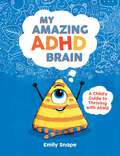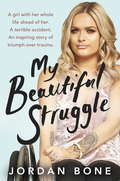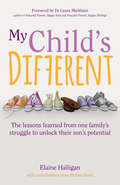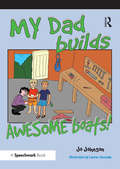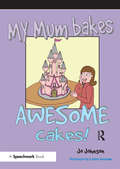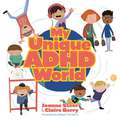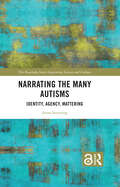- Table View
- List View
My Amazing ADHD Brain: A Child's Guide to Thriving with ADHD
by Emily SnapePip is a confident little monster who has ADHD. In this book, they share what that means for them and how it has some really brilliant benefits.My Amazing ADHD Brain is packed with reassuring words, practical advice and skill-building activity ideas, and has a fun, relatable voice.
My Autism Book: A Child's Guide to their Autism Spectrum Diagnosis (PDF)
by Glòria Durà-Vilà Tamar LeviMy Autism Book is a beautifully illustrated picture book that helps parents to explain an autism diagnosis to their child in a sensitive, positive and accurate way. When a child is diagnosed with an Autism Spectrum Disorder (ASD), parents often feel overwhelmed and uncertain about how to communicate the diagnosis to their child. This book is designed to be read with the child as a simple introduction to their diagnosis. Written by a doctor and a children's author, the book is tailored precisely to the needs and experiences of the child with ASD aged 5 and up. It explains what an autism diagnosis means and encourages an exploration of the child's likely strengths and differences using clear language that speaks directly to the child. The colourful pictures throughout show how the world looks from the child's perspective and the book ends with a summary checklist to encourage the child to record and discuss how autism affects them.
My Beautiful Struggle
by Jordan BoneA girl with her whole life ahead of her. A terrible accident. An inspiring story of triumph over trauma. Aged 15, Jordan was a happy-go-lucky girl; having fun with friends and loving life. In one fateful moment, everything changed. A car accident left her paralysed from the chest down and shocked her into deep depression. She was on the brink of giving up. But gradually Jordan realised there is hope beyond utter devastation, and life beyond disability.Painstakingly re-learning how to apply her beloved make-up, Jordan began to rebuild her sense of self and empowerment. Her body may have been broken but her spirit was not. She is now a successful beauty blogger and her journey of positivity inspires millions around the world.MY BEAUTIFUL STRUGGLE is the incredible true story of how one young woman overcame immense challenges, of inner strength that lies beneath outer beauty, of how to believe in yourself and find the light when it feels like all hope is gone.
My Book of Feelings: A Book to Help Children with Attachment Difficulties, Learning or Developmental Disabilities Understand their Emotions (PDF)
by Rosy Salaman Tracey RossEven though you can't see them, we all have feelings. Some feelings are fluffy and make us feel good. Some are sharp and make us unhappy. Sometimes we have fluffy and sharp feelings at the same time! It's ok to have different types of feelings, but there are some things we can do to let the sharp feelings out when they get too big, or when we have too many. This picture book is ideal for children ages 5 and above to help them understand why they might experience different emotions, and what they can do to help them manage their emotions in a positive way. Written in simple language, this book will be an excellent tool for any child who finds it difficult to understand their emotions, particularly those with attachment difficulties, or a learning or developmental disability.
My Child's Different: The lessons learned from one family's struggle to unlock their son's potential
by Elaine HalliganElaine Halligan’s My Child’s Different: The lessons learned from one family’s struggle to unlock their son’s potential explores the enabling role that parents can play in getting the best out of children who are seen as ‘different’ or ‘difficult’. Foreword by Dr Laura Markham. Society favours children, and adults, who conform. The notion that our children may be shunned for being ‘different’ breaks our hearts, but there is plenty we can do to help such children develop into thriving, resilient adults. In My Child’s Different Elaine shares the true story of her son Sam, who by the age of seven had been excluded from three schools and was later labelled with a whole host of conditions – ranging from autistic spectrum disorder (ASD) to pathological demand avoidance (PDA), before finally being diagnosed with dyslexia. He had become ‘the Alphabet Kid’. His family never gave up on him, however … Drawing lessons from Sam’s transformational journey from difficult child to budding entrepreneur, My Child’s Different offers encouragement to parents who may be concerned about what the future might hold, and demonstrates how – with the right support and positive parenting skills – their children can grow up to surprise and delight them. The book chronicles Sam’s journey from birth to adulthood, allowing readers to spot past and present patterns that may be comparable with their own children’s experiences, and provides pragmatic parenting advice that will be of benefit to any parent whose children – who may or may not have a diagnosed learning difficulty – struggle with life educationally or socially. Elaine writes with warmth and compassion as she revisits the challenges faced, the obstacles overcome and the key interventions that helped instil in Sam a sense of self-belief, a drive to succeed and an emotional intelligence beyond his years. Interspersed throughout the narrative are the reflections and insights of parenting expert Melissa Hood, who illustrates the key concepts from Sam’s story and shares practical positive parenting techniques to help parents better connect with their children. Also included are contributions from Sam himself – providing an additional, uniquely rich perspective that will help deepen parents’ understanding of their children’s feelings and emotions. Suitable for parents, educators and anyone who works with children, My Child’s Different is a celebration of all the unique qualities that those who are different bring to society. Chapters include: 1. Us, and Our Blue-Eyed Boy (The Calm Before the Storm); 2. I’m Sure It’ll All Be Fine (Pre-School); 3. Naughty, Stupid Little Child (Primary School); 4. There Has to Be Another Way (Out of School); 5. This Changes Everything (Back to School); 6. Revealing the Diamond (Secondary School); 7. Moving On Up (Sixth Form); 8. Anything Is Possible (Adulthood).
My Dad Makes Awesome Boats
by Jo Johnson'My dad makes awesome boats' is a story book for primary aged children. The story is about two friends, Oscar and Samuel. Oscar's dad has a diagnosis of multiple sclerosis. It creates an opportunity to talk with children about the symptoms of MS as well as other aspects of friendship like competition, strengths and weaknesses and talking to each other. It includes a question on each page, eg, 'what do you like doing with your dad' and 'what makes you feel sad' to help discussion about all aspects of living with a relative with multiple sclerosis. It includes activity pages, a relevant word search, spot the difference and drawing pages that allow children to have fun as they talk about what is happening in their lives. The book will be useful for families, therapists, health professionals and teachers to use with children who have a relative with MS or with all children to raise awareness of a common health diagnosis as another example of diversity. "This book is excellent, it will help families as it is talking about very routine things that children understand. This will be a fantastic resource for children, teachers and health professionals". (Katrina Orchard MS specialist nurse).
My Dad Makes the Best Boats
by Jo Johnson'How can we talk to our children about Brain Injury?' This is a regularly asked question by parents who have suffered a brain injury and their respective partners. This book has been designed so that children between five and eight can read it independently. However, ideal if should be used with an adult to facilitieate discussion about all aspects of family life and to enhance general emotional wellbeing. This book deliberately makes brain injury one of many things going on for this small group of children because for most children it is only one of many issues in their family life. This story is intended to emphasize that all families are different, with their own strengths and weaknesses and different experiences. Brain injury is another experience that some people encounter and others do not. 'My Dad Makes the Best Boats' should prove to be a great reassurance and comfort for children coping with a parent's brain injury. The book presents situations in which brain injured people can be angry, forgetful or unreasonable and shows that it is not the fault of either parent or child and children should not blame themselves. It also demonstrates the positive aspects of life with a brain injured parent and the enjoyable times that can be spent together'. Headway: The Brain Injury Association 'This book has proved to be a very useful support mechanism for service users and families in the Brain Injury Rehabilitation Trust. We are sure that this will continue to be the case, especially with the inclusion of new activity pages; Professor Michael Oddy, Director of Clinical Services Brain Injury Rehabilitiation Trust.
My Friend Daniel Doesn't Talk
by Sharon LongoWhen outgoing Ryan meets Daniel, a boy who is too afraid to talk in school or other places outside of his home, he befriends the silent boy, defending him in school to the other children. Their friendship grows, and Daniel feels comfortable enough to talk to his new friend. Ryan's tendency to 'talk too much' enables him to help Daniel in the classroom, and he hopes for the day when his friend will be able to talk in school so that the other children may get to know the 'real' Daniel. In the meantime, he is willing to continue to be a friend to Daniel until that day. This beautifully illustrated story book is for children with severe shyness, social anxiety or selective mutism to see that they can make a friend like Ryan. It is also a helpful tool for friends of children like Daniel to understand why these children are unable to talk in certain settings.The theme - of accepting others who are different while trying to emphasise with them - is a universal one, and therefore this book may be enjoyed by all children aged from 4 to 8. While the story should not be read to the class while the child is present or without his or her permission, this book is an invaluable tool for teachers trying to understand selective mutism, and wanting to explain it to their students. For comprehensive advice and information on selective mutism, please see "The Selective Mutism Resource Manual" (Speechmark, 2001). BMA Medical Book Competition Winner Highly Commended in the BMA Patient Information Awards (Printed Materials), "My Friend Daniel Doesn't Talk" really impressed the judges: 'This leaflet has been written by a parent of a child with selective mutism who has written numerous articles on the subject'.'It is written for children to help explain some of the issues around children who 'don't talk' and has been beautifully produced and introduces a sensitive topic via a lovely story about friendship which is a great way to engage with children and inform them about a subject without making it 'an issue' and risk stigmatising a child even more...I loved the illustrations and the characters were portrayed with a gentleness and sensitivity which made the story very likeable. The humour in the story is subtle and effective and unlike many 'stories with a message' written for children, this book is a pleasurable read in its own right, and stands up as a lovely story book, but with the added bonus of including the universal theme of 'being different' and in particular providing a basic explanation for selective mutism. I really loved this book'.'What really came through, is that it was written with real thought, care and from someone who really understands and empathises with the subject matter. Well done!'.
My Friend Daniel Doesn't Talk
by Sharon LongoWhen outgoing Ryan meets Daniel, a boy who is too afraid to talk in school or other places outside of his home, he befriends the silent boy, defending him in school to the other children. Their friendship grows, and Daniel feels comfortable enough to talk to his new friend. Ryan's tendency to 'talk too much' enables him to help Daniel in the classroom, and he hopes for the day when his friend will be able to talk in school so that the other children may get to know the 'real' Daniel. In the meantime, he is willing to continue to be a friend to Daniel until that day. This beautifully illustrated story book is for children with severe shyness, social anxiety or selective mutism to see that they can make a friend like Ryan. It is also a helpful tool for friends of children like Daniel to understand why these children are unable to talk in certain settings.The theme - of accepting others who are different while trying to emphasise with them - is a universal one, and therefore this book may be enjoyed by all children aged from 4 to 8. While the story should not be read to the class while the child is present or without his or her permission, this book is an invaluable tool for teachers trying to understand selective mutism, and wanting to explain it to their students. For comprehensive advice and information on selective mutism, please see "The Selective Mutism Resource Manual" (Speechmark, 2001). BMA Medical Book Competition Winner Highly Commended in the BMA Patient Information Awards (Printed Materials), "My Friend Daniel Doesn't Talk" really impressed the judges: 'This leaflet has been written by a parent of a child with selective mutism who has written numerous articles on the subject'.'It is written for children to help explain some of the issues around children who 'don't talk' and has been beautifully produced and introduces a sensitive topic via a lovely story about friendship which is a great way to engage with children and inform them about a subject without making it 'an issue' and risk stigmatising a child even more...I loved the illustrations and the characters were portrayed with a gentleness and sensitivity which made the story very likeable. The humour in the story is subtle and effective and unlike many 'stories with a message' written for children, this book is a pleasurable read in its own right, and stands up as a lovely story book, but with the added bonus of including the universal theme of 'being different' and in particular providing a basic explanation for selective mutism. I really loved this book'.'What really came through, is that it was written with real thought, care and from someone who really understands and empathises with the subject matter. Well done!'.
My Left Foot: The Life That Inspired My Left Foot
by Christy BrownChristy Brown was born a victim of cerebral palsy. But the hapless, lolling baby concealed the brilliantly imaginative and sensitive mind of a writer who would take his place among the giants of Irish literature. This is Christy Brown's own story. He recounts his childhood struggle to learn to read, write, paint and finally type, with the toe of his left foot. In this manner he wrote his bestseller Down all the Days.
My Mum Bakes Awesome Cakes: Neurorology Series: Talking About MS
by Jo Johnson'My mum bakes awesome cakes' is a story book for primary school aged children. The story is about a small group of children. Leah's mum has a diagnosis of multiple sclerosis. It creates an opportunity to talk with children about the symptoms of MS as well as other aspects of friendship like anxiety, competition, strengths and weaknesses and talking to each other. It includes a question on each page, eg, 'what do you like doing with your dad' and 'what makes you feel sad' to help discussion about all aspects of living with a relative with multiple sclerosis. It includes activity pages, a relevant word search, spot the difference and drawing pages that allow children to have fun as they talk about what is happening in their lives. This book will be useful for families, therapists, health professionals and teachers to use with children who have a relative with MS or with all children to raise awareness of a common health diagnosis as another example of diversity. "This book is fantastic, it is the perfect tool to start conversations with children. It gives straightforward explanations of symptoms without being too medical. This will be a great resource for families, teachers and health professionals". (Lisa black MS specialist nurse).
My Mum Makes the Best Cakes
by Jo Johnson'How can we talk to our children about Brain Injury?' This is a regularly asked question by parents who have suffered a brain injury and their respective partners. This book has been designed so that children between five and eight can read it independently. However, ideally it should be used with an adult to facilitate discussion about all aspects of family life and to enhance general emotional wellbeing. This book deliberately makes brain injury one of many things going on for this small group of children because for most children it is only one of many issues in their family life. This story is intended to emphasise that all families are different, with their own strengths and weaknesses and different experiences. Brain injury is another experience that some people encounter and others do not. 'My Mum makes the Best Cakes' should prove to be a great reassurance and comfort for children coping with a parent's brain injury. The book presents situations in which brain injured people can be angry, forgetful or unreasonable and shows that it is not the fault of either parent or child and children should not blame themselves. It also demonstrates the positive aspects of life with a brain injured parent and the enjoyable times that can be spent together'. Headway: The Brain Injury Association. "This book has proved to be a very useful support mechanism for service users and families in the Brain Injury Rehabilitation Trust. We are sure that this will continue to be the case, especially with the inclusion of new activity pages." (Professor Michael Oddy, Director of Clinical Services Brain Injury Rehabilitation Trust).
My Mummy is Autistic: A Picture Book and Guide about Recognising and Understanding Difference
by Heath Grace Joanna GraceThis original and imaginative book has been created by five-year-old Heath. In it, Heath illustrates his understanding of his autistic mother Joanna, giving insight into the different ways in which autistic and neurotypical people understand language. In his simple and uncomplicated style, accompanied by bright and colourful illustrations, Heath explains why his mother’s brain understands words at a different rate than his own, and how they communicate in spite of their differences. Heath’s work is accompanied by explanatory notes exploring Joanna’s own experience of autism and language. Key features include: A Foreword by broadcaster, environmentalist and author Chris Packham, on acceptance, understanding, and expressing an autistic reality A unique exploration of language processing differences told through the eyes and mind of a child. Bright, colourful pictures and simple language, perfect for inspiring conversations about neurodiversity between people of all ages. Explanatory text that can be read alongside the story. Autism portrayed as a positive and permanent neurological difference, not deficit. The combination of story and commentary makes this book a unique tool for all people seeking to explain and understand difference, regardless of age and experience. Although focusing on autism as an example of neural difference, it can be used to explain and celebrate neurodiversity in all its forms and will help to build relationships across the divide of neurological difference.
My Mummy is Autistic: A Picture Book and Guide about Recognising and Understanding Difference
by Joanna Grace Heath GraceThis original and imaginative book has been created by five-year-old Heath. In it, Heath illustrates his understanding of his autistic mother Joanna, giving insight into the different ways in which autistic and neurotypical people understand language. In his simple and uncomplicated style, accompanied by bright and colourful illustrations, Heath explains why his mother’s brain understands words at a different rate than his own, and how they communicate in spite of their differences. Heath’s work is accompanied by explanatory notes exploring Joanna’s own experience of autism and language. Key features include: A unique exploration of language processing differences told through the eyes and mind of a child. Bright, colourful pictures and simple language, perfect for inspiring conversations about neurodiversity between people of all ages. Explanatory text that can be read alongside the story. Autism portrayed as a positive and permanent neurological difference, not deficit. The combination of story and commentary makes this book a unique tool for all people seeking to explain and understand difference, regardless of age and experience. Although focusing on autism as an example of neural difference, it can be used to explain and celebrate neurodiversity in all its forms and will help to build relationships across the divide of neurological difference.
My Senses Are Like Cups: What to Do When Everything Feels Too Much or Not Nearly Enough
by Clare Ward James GalpinThink about our senses being like cups and everything we see, hear, feel, smell, touch, and taste as we move about is like water going into our cups. Some of our cups might be big and some might be small. Whether big or small, we like it best when our cup is filled enough so that it's just right for us! We are all different. We need just the right amount of information to feel good! Help your child aged 7+ think about, explore and develop ways to manage sensory overload and feeling under stimulated with quirky cartoons that visually illustrate the approach. Sections on each of the eight senses (including your internal 'body signals' like hunger) feature noticing and knowledge-building activities to help kids get their own, unique, senses cups feeling 'just right' for them. Get going on some sensory experiments!
My Son's Not Rainman: One Man, One Autistic Boy, A Million Adventures
by John WilliamsThis isn’t a story about autism. It’s a story about a young boy who happens to have autism, and there is a difference.John Williams is a stand-up comedian. He is also a single father and full-time carer for his son, who has autism and cerebral palsy. This is their incredible story.In 2012, John started a blog called My Son’s Not Rainman, a heartfelt and uplifting account of everyday life for him and ‘The Boy’. Following on from the blog’s amazing success, John felt there was still much more of their life, past and present, that he wanted to share. And not only of the challenges of bringing up a child who for too long was just dismissed as ‘difficult’, but also of the joy of living with someone who looks at the world in a unique way.My Son’s Not Rainman radiates warmth, care and passion, not to mention laugh-out-loud humour, on every page. It is a brilliantly different story about a brilliantly different boy.
My Special Alphabet Book: A Green-Themed Story and Workbook for Developing Speech Sound Awareness for Children aged 3+ at Risk of Dyslexia or Language Difficulties
by Helen Likierman Valerie MuterCan you spot Dinaroo and her friends and see what they have found in the dump? Can they recycle it? Or make something new? Written by two leading psychologists, the engaging, colourful, fully illustrated alphabet story in the first part of this book is accompanied by an extensive workbook section. Here you find exercises, in the form of games, to develop the important component skills needed for reading and learning about printed letters. Together you and the child will be able to practice the phoneme (speech sound) awareness and other fundamental language skills that are so important, and often difficult to acquire, for young children who may have dyslexia or speech and language problems. My Special Alphabet Book will provide the vital early support these young children need in literacy. It also includes a user-friendly guide for parents and teachers, as well as extension activities to build awareness of environmental issues.
My Unique ADHD World
by Joanne Steer Claire Berry"They just don't get it!" I bet you have said that before... Maybe if you knew more about ADHD, you could help your friends, family and teachers understand too. Everyone has things they are good at and things they find more difficult. ADHD can give you some special strengths - however, it can also make some things more difficult for you. Let's explore what ADHD means for you with fun facts and by hearing all about other ADHD children's experiences too!You can even write (or doodle) what you already know and what you have learnt about so that you can teach your friends, family and teachers all about you and YOUR UNIQUE ADHD!
The Myriad Gifts of Asperger's Syndrome (PDF)
by John M. OrtizA fascinating collection of real-life personal profiles, The Myriad Gifts of Asperger's Syndrome focuses on the talents, abilities, and achievements of individuals with Asperger's Syndrome (AS). Vaschel has a remarkable connection with animals; Richard can tell the weight of any item he lifts to the nearest tenth of a pound; two-year-old Hannah detected a dangerously faulty electrical circuit in her family home; and eight-year-old Clark became conversant in French after only an evening's study. What connects these individuals? They all have AS. John M. Ortiz celebrates the qualities of individuals with AS he has met through his clinical experience, including their characteristic tenacity, honesty, and attention to detail, and looks also at the wide range of careers they have chosen and in which they flourish. This uplifting book should be read and enjoyed by anyone who knows or works professionally with individuals with AS, and anyone with an interest in the subject.
Narrating the Many Autisms: Identity, Agency, Mattering
by Anna StenningAutism is a profoundly contested idea. The focus of this book is not what autism is or what autistic people are, but rather, it grapples with the central question: what does it take for autistic people to participate in a shared world as equals with other people? Drawing from her close reading of a range of texts, by autistic authors, filmmakers, bloggers, and academics, Anna Stenning highlights the creativity and imagination in these accounts and also considers the possibilities that emerge when the unexpected and novel aspects of experience are attended to and afforded their due space. Approaching these narrative accounts in the context of both the Anthropocene and neoliberalism Stenning unpacks and reframes understandings about autism and identity, agency and mattering, across sections exploring autistic intelligibility, autistic sensibility, and community-oriented collaboration and care. By moving away from the non-autistic stories about autism that have, over time, dominated public conception of the autistic experience and relationships, as well as the cognitive and psychoanalytic paradigms that have reduced autism and autistic people to a homogeneous group, the book instead reveals the multiplicity of autistic subjectivities and their subsequent understandings of oppression. It calls on readers to listen to what autistic people have to say about the possibilities of resistance and solidarity against intersecting currents and eddies of power, which endanger all who challenge the neoliberal conception of Life. A stirring and meaningful departure from atomized accounts of neurological difference, Narrating the Many Autisms ponders big questions about its topic and finds clarity and meaning in the sense-making practices of autistic individuals and groups. It will appeal to scholarly readers across the fields of disability studies, cultural studies, critical psychology, sociology, anthropology, and literature. The Open Access version of this book, available at http://www.taylorfrancis.com, has been made available under a Creative Commons [Attribution-Non Commercial-No Derivatives (CC-BY-NC-ND)] 4.0 license.
Narrating the Many Autisms: Identity, Agency, Mattering
by Anna StenningAutism is a profoundly contested idea. The focus of this book is not what autism is or what autistic people are, but rather, it grapples with the central question: what does it take for autistic people to participate in a shared world as equals with other people? Drawing from her close reading of a range of texts, by autistic authors, filmmakers, bloggers, and academics, Anna Stenning highlights the creativity and imagination in these accounts and also considers the possibilities that emerge when the unexpected and novel aspects of experience are attended to and afforded their due space. Approaching these narrative accounts in the context of both the Anthropocene and neoliberalism Stenning unpacks and reframes understandings about autism and identity, agency and mattering, across sections exploring autistic intelligibility, autistic sensibility, and community-oriented collaboration and care. By moving away from the non-autistic stories about autism that have, over time, dominated public conception of the autistic experience and relationships, as well as the cognitive and psychoanalytic paradigms that have reduced autism and autistic people to a homogeneous group, the book instead reveals the multiplicity of autistic subjectivities and their subsequent understandings of oppression. It calls on readers to listen to what autistic people have to say about the possibilities of resistance and solidarity against intersecting currents and eddies of power, which endanger all who challenge the neoliberal conception of Life. A stirring and meaningful departure from atomized accounts of neurological difference, Narrating the Many Autisms ponders big questions about its topic and finds clarity and meaning in the sense-making practices of autistic individuals and groups. It will appeal to scholarly readers across the fields of disability studies, cultural studies, critical psychology, sociology, anthropology, and literature. The Open Access version of this book, available at http://www.taylorfrancis.com, has been made available under a Creative Commons [Attribution-Non Commercial-No Derivatives (CC-BY-NC-ND)] 4.0 license.
Narrative Approaches in Play with Children
by Alison Webster Ann CattanachNarrative play is a way of communicating with children using imaginative stories and narratives to share and make sense of life events. This book describes using narrative play therapeutically with children who have lived in multiple families, children who have problems with social understanding and children who have learning difficulties. Ann Cattanach explains how children's stories and narratives, whether they are about real or imagined events, can be interpreted as indicators of their experiences, their ideas, and a dimension of who they are. She demonstrates this with examples of children's stories from her clinical experience, and provides narrative play techniques and sample scripts both for therapists and for parents whose circumstances require a therapeutic parenting approach. This book is essential reading for play therapists, social workers and other professionals working with children, as well as parents and carers of children who are experiencing social and/or learning difficulties.
Narrative Approaches in Play with Children (PDF)
by Alison Webster Ann CattanachNarrative play is a way of communicating with children using imaginative stories and narratives to share and make sense of life events. This book describes using narrative play therapeutically with children who have lived in multiple families, children who have problems with social understanding and children who have learning difficulties. Ann Cattanach explains how children's stories and narratives, whether they are about real or imagined events, can be interpreted as indicators of their experiences, their ideas, and a dimension of who they are. She demonstrates this with examples of children's stories from her clinical experience, and provides narrative play techniques and sample scripts both for therapists and for parents whose circumstances require a therapeutic parenting approach. This book is essential reading for play therapists, social workers and other professionals working with children, as well as parents and carers of children who are experiencing social and/or learning difficulties.
Narrative Intervention Programme
by Victoria JoffeThis book improves the understanding and telling of stories in secondary school students and young adults. Specifically designed for older children and young adults, this practical language programme was created by a specialist speech & language therapist with input from secondary school teachers and students. It focuses on enhancing the understanding and expression of stories in students aged from 8 to 18 with language and communication difficulties, and aims to: create an awareness of how storytelling can be used to enhance learning in school and social interactions in school and home environments. It facilitates storytelling. It enhances the joy and enjoyment in telling stories. It identifies different types of narratives and provide examples for each type. It encourages effective listening and attention skills. It examines different means of making story production more interesting through vocal variety, body language and print. It encourages the use of the story planner in planning and structuring essays in the classroom and for homework. Dr Victoria Joffe is a specialist speech and language therapist and senior lecturer in developmental speech, language and communication impairments in the Department of Language and Communication Science at City University, London. Victoria runs various workshops for PCT's, LEA's and schools on child speech disorder, evidence based practice in speech and language therapy and collaborative practice in education and provides training for therapists and teaching staff on working with children and young adults with speech, language and communication needs in education. Victoria is currently involved in a large scale intervention project funded by the Nuffield Foundation on enhancing language and communication in secondary school children with language impairments on which this programme is based.
Narrative Intervention Programme
by Victoria JoffeThis book improves the understanding and telling of stories in secondary school students and young adults. Specifically designed for older children and young adults, this practical language programme was created by a specialist speech & language therapist with input from secondary school teachers and students. It focuses on enhancing the understanding and expression of stories in students aged from 8 to 18 with language and communication difficulties, and aims to: create an awareness of how storytelling can be used to enhance learning in school and social interactions in school and home environments. It facilitates storytelling. It enhances the joy and enjoyment in telling stories. It identifies different types of narratives and provide examples for each type. It encourages effective listening and attention skills. It examines different means of making story production more interesting through vocal variety, body language and print. It encourages the use of the story planner in planning and structuring essays in the classroom and for homework. Dr Victoria Joffe is a specialist speech and language therapist and senior lecturer in developmental speech, language and communication impairments in the Department of Language and Communication Science at City University, London. Victoria runs various workshops for PCT's, LEA's and schools on child speech disorder, evidence based practice in speech and language therapy and collaborative practice in education and provides training for therapists and teaching staff on working with children and young adults with speech, language and communication needs in education. Victoria is currently involved in a large scale intervention project funded by the Nuffield Foundation on enhancing language and communication in secondary school children with language impairments on which this programme is based.
